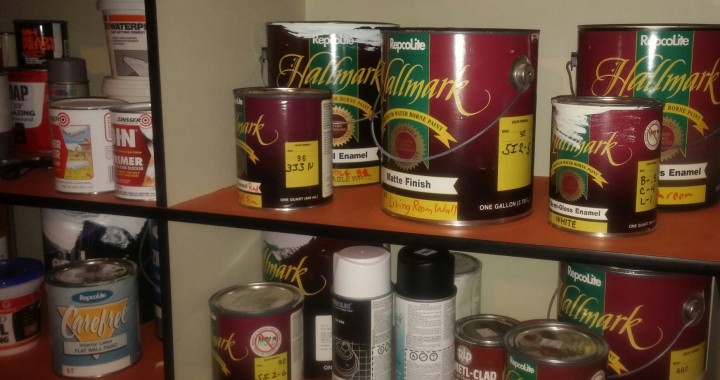 The search for the perfect method to properly store paint is one of those Holy Grail-type quests in the painting world. Everybody everywhere has an idea (or two) as to the best ways to ensure that your paint doesn’t dry out in the can as it sits on your shelf.
The search for the perfect method to properly store paint is one of those Holy Grail-type quests in the painting world. Everybody everywhere has an idea (or two) as to the best ways to ensure that your paint doesn’t dry out in the can as it sits on your shelf.
Some people argue that the ideal thing to do is to store your can upside down–because it will prevent air from seeping in. Others claim that the best thing to do is to lay a sheet of plastic wrap over the opening before pounding the lid on: this will provide an extra seal, again preventing air from seeping in. Some folks pour water into their paint before they store it, others coat the rim with vasoline, others vacuum seal the can little plastic bags.
The ideas are endless, but really, most of them either don’t work or simply aren’t necessary. (We’ll deal with some of these methods and discuss why they don’t work and should be avoided in a later blog entry).
For now, instead of focusing on all the novelty ideas out there, here are 4 tips–solid, reality-based tips–that will help you make sure that the paint you store today will still be ready to use in a few years.
1. Transfer your paint to a smaller container you can fill to the top.
If your paint gallon or quart is half full or less, don’t just pop the lid on and store it that way–it will dry out quickly. Instead, move it to a smaller, sealable container that you can fill to the top. This will keep it in liquid form much, much longer. A variety of different containers will work in these situations–the key is that you’re able to fill the container AND that it will seal well.
2. Keep the rim of your container free from built-up paint.
Many people use the rim of their can as a “wipe off” point for their brush. As a result, paint accumulates in the rim and can often be dried and hardened by the time you’re ready to put the lid back on.
Avoid this by using a pour spout (available for less than $1 at any RepcoLite store) and working out of a secondary container (this is important for other reasons as well–see here). This way you can keep the rim of your paint can clean and free of paint.
When you’re finished painting, take a couple extra minutes, before storing your paint on your shelf, to wash and clean out the rim so that your lid can achieve a good, tight seal. If there’s paint in the rim you can’t clean out because it has hardened, use a rag and some hot water.

A relatively bored-looking Thor.
3. When putting the lid on your container, use restraint!
You may have the power, the rage, the enthusiasm of Thor (see inset and then imagine more power, more rage, and more enthusiasm), but please, don’t use those superpowers when pounding on the lid. It will only result in sorrow, misery and a bad seal that will cause your paint to dry out prematurely.
See, pounding the lid on with extreme force (some might say ‘brutality’) never works. We’ve all done this. We’ve all thought “if I just hit it hard enough, it will go on.” Well, it doesn’t. It just bends the can, warps the lid and prevents the can from ever sealing well again.
So use restraint. If you follow Step 2 and keep the rim clean and free from paint, you should be able to tap the lid gently on with a small rubber mallet.
4. Store your paint in an area that is not subjected to extreme temperature changes.
This rules out most of our Michigan garages. Once latex paint freezes and thaws, it’s usually unusable–so find a good storage place in an area with controlled temperatures. (Think basement or lower level storage area!)
Do these things, take these precautions and you’ll find that 5 years from now, when you need to do a couple touch-ups, your paint is still usable and in perfect shape.

